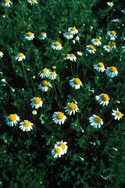
Photo © Steven Foster
Introduction
Roman chamomile is an aromatic perennial with feathery leaves and daisy-like flowers.1 The herb rarely grows above 9 inches making it a good ground cover for gardens. The plant is native to Western Europe, North America, and the Azores. The flowers and essential oil are the parts most commonly utilized today.1 History and Cultural Significance
Chamaemelum nobile has a long history of use in Britain.2 Although commonly referred to as Roman chamomile, the British did not introduce the plant to Rome until the 16th century CE. When the leaves of the plant are bruised, an apple fragrance is released. The Greeks noticed this unique characteristic and named the plant chamomile, which is derived from chamai meaning ‘apple on the ground’.2 The flower has been used internally for digestive problems, upset stomach, and temper tantrums in children. Externally, the flowers can be used to soothe irritated skin. The essential oil has been employed in aromatherapy and applied externally to soothe diaper rash1 and minor muscle and joint pain.3 It can also be found in skin care products and tonic preparations.3 The British Herbal Compendium indicates Roman chamomile topically for soothing inflammation of the skin and mouth, abrasions and minor wounds.4 Roman chamomile is a flavoring in a variety of alcoholic beverages,2 and is used in soaps, cosmetics, detergents, perfumes, and hair and bath products.3 Modern Research
There are currently no clinical studies available on the internal or external uses of Roman chamomile. Future Outlook
Currently there is no information available on market statistics, commercial production, or sustainable harvesting of Chamaemelum nobile. References
1 Bown D. The Herb Society of America New Encyclopedia of Herbs & Their Uses. London: Dorling Kindersley Ltd.; 2001. 2 Onstad D. Whole Foods Companion. White River Junction, VT: Chelsea Green Publishing Co.; 1996. 3 Lawless J. The Illustrated Encyclopedia of Essential Oils: The Complete Guide to the Use of Oils in Aromatherapy and Herbalism. Dorset, UK: Element Books Limited; 1995. 4 Bradley PR. British Herbal Compendium. Dorset, UK: British Herbal Medicine Association; 1992.
|